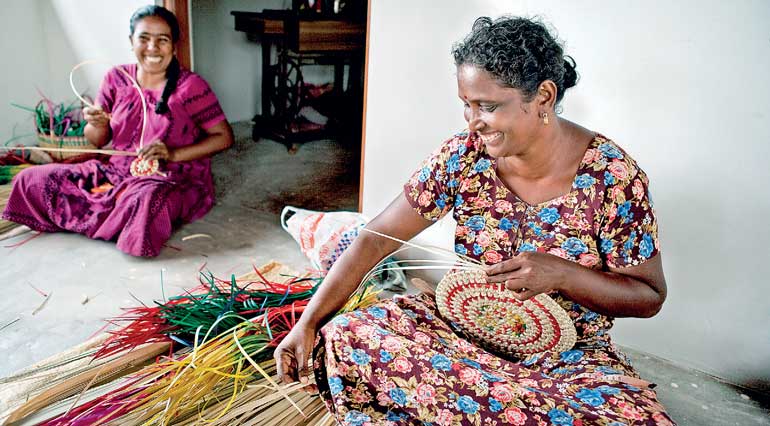Tuesday Mar 11, 2025
Tuesday Mar 11, 2025
Tuesday, 9 May 2017 00:00 - - {{hitsCtrl.values.hits}}
 Interestingly, Sri Lanka has one of the most educated female labour force in the region, but participation rates are still low. Raising female labour participation can unlock further Sri Lanka’s economic potential
Interestingly, Sri Lanka has one of the most educated female labour force in the region, but participation rates are still low. Raising female labour participation can unlock further Sri Lanka’s economic potential
By Eteri Kvintradze
The April 2017 Regional Economic Outlook for Asia and Pacific: Preparing for Choppy Seas finds that policy stimulus continues to support healthy domestic demand in China and Japan in the near term, which is good for other economies in Asia as well. Broader global conditions are also favourable.
Growth is accelerating in many major advanced and emerging market economies, notably the United States and commodity exporters, and financial markets are still resilient for the most part. Nonetheless, there are challenges ahead. Particularly, over the mediumterm,there are fundamental headwinds to sustained strong growth, including from aging populations in some countries and a slower catch-up in productivity.
After a slowdown in 2016,regional growth is forecast to speed up in 2017
Growth in the region decelerated to 5.3% in 2016 from 5.6% in 2015 despite broad improvement in economic activity in the second half of 2016. Net exports continued to pull down growth; domestic demand remained strong, supported by robust private consumption.
GDP growth is forecast to reach 5.5% in 2017, revised up by 0.1 percentage point compared to the estimate in the IMF’s October 2016 World Economic Outlook, and 5.4% in 2018. Accommodative policies will underpin domestic demand, offsetting tighter global financial conditions. The acceleration in 2017 reflects expected recovery in Asian trade, resilient domestic demand, and continued policy support.
The aggregate outlook for the region, however, masks differences across countries
Among the larger economies, projected growth in China and Japan for 2017 was revised up because of continued policy support and strong data toward the end of 2016. China’s GDP growth is expected to stay strong but continue to slow gradually to 6.6% in 2017 as recent tightening measures take effect—and to 6.2% in 2018. Japan’sgrowth isprojected at 1.2%, withmomentum set to continue into 2017,but will probably then weaken along withfiscal policy consolidationand the planned consumption tax increase.
Some of the upward revision in Japan reflects the comprehensive revision of the national accounts in 2016. In India, temporary disruptions (primarily to private consumption) caused by cash shortages accompanying the currency exchange initiative are expected to gradually dissipate in 2017. Thus, growth is projected to rebound to 7.2% in FY2017/18 and to 7.7% in FY2018/19. In Korea, growth is expected to remain subdued at 2.7% in 2017, owing to geopolitical uncertainty, and increase to 2.8% in 2018. Projected growth for Asia, excluding India and Korea, was revised up in 2017 by 0.3 percentage point compared to the estimate in the October 2016 World Economic Outlook.
Near-term growth is encouraging, but downside risks continue to dominate the economic landscape
Global growth could get a boost from economic stimulus in some large economies, particularly the United States. However, continued tightening in global financial conditions could trigger further capital flow volatility.
Private debt has risen in many economies in the region over the past decade, and higher borrowing costs could tip some companies and households over the edge and constrain growth. More inward-looking policies in major global economies would significantly impact Asia given that the region has benefited substantially from cross-border economic integration. A bumpier-than-expected transition in China would also have serious repercussions
Medium-term regional growth faces challenges from population ageing and slowing productivity
Asia is a diverse region, and some areas risk growing old before becoming rich. This is because the pace of ageing is faster in Asia compared with the experience in Europe and the United States. For many countries in the region, on current trends, per capita income (benchmarked against the United States) will be much lower than that reached by advanced economies at a similar peak in their ageing cycle.
Slowing productivity growth since the global financial crisis, which kept the region from catching up with the United States and other countries at the technological frontier, has made matters worse. The slowdown has been most severe in the advanced economies of the region. Without reforms, productivity growth will likely remain low for some time, with headwinds from rapid ageing becoming increasingly important.
Growth can be reinforced by appropriate demand support and structural reforms
Buffers are needed, especially for countries nearing full productive capacity. Policymakersshould also deploy macroeconomic policies to support and complement structural reforms and external rebalancing and, if needed, to boost demand. Exchange rate flexibility should generally remain the main shock absorber against a sudden tightening in global financial conditions or a shift toward protectionism in major trading partners.
Policymakers should continue to rely on macroprudential policies to mitigate financial stability risks. But what is really needed is structural reforms to meet challenges of changing demographics to boost productivity. At the top of the list are labour market and pension system reforms.
Advanced economies should focus on strengthening the effectiveness of research and development spending and taking measures to raise productivity in the services sectors. Emerging and developing economies must focus on attracting foreign direct investment and expanding the economy’s capacity to absorb new technology and boost domestic investment.
Sri Lanka has a compelling growth
The economy has grown on average over 5.6% during the last 15 years, but growth has been uneven due to both external and domestic conditions. During this period the country has transitioned from war to durable peace, scaled up infrastructure, and changed governments. Economic growth held up in 2016 at 4.4% despite fiscal consolidation and weather-related shocks, supported by industry and service sectors, and improved confidence following the EFF program agreement. To raise growth further, Sri Lanka needs to boost its total factor productivity from its current low levels and the capital stock will also have to grow.
Sri Lanka is at a critical juncture where both private and public sectors have roles to play
International experiences have shown that enabling business environment is an important catalyst of private sector led growth. Public sector has to create enabling environment for businesses to innovate, create jobs, trade, and compete.
In Sri Lanka, burdensome and uncertain regulatory environment is often quoted as one of the main concerns of the private sector. For example, proliferation of para-tariffs has made Sri Lanka one of the most protected economies, and case-by-case investment incentives have failed to boost FDI. Regulatory reforms that remove economic and policy uncertainty can stimulate private sector activity and lead to greater productivity growth. Predictable, fair and automated tax systems are central to creating a stable and transparent business environment.
To this end Government’s efforts to bring new income tax legislation, with effective public consultations, is a critical step towards rebalancing the tax system toward a more predictable, efficient and equitable structure.
Finally, achieving inclusive growth requires actions that go beyond immediate macro-stabilisation
Well-designed public investment and education programs could raise underlying growth and increase the earning potential of low-income people. Educating girls and engaging them in the labour market also gives high returns to investment. Interestingly, Sri Lanka has one of the most educated female labour force in the region, but participation rates are still low. Raising female labour participation can unlock further Sri Lanka’s economic potential.
The writer is the Resident Representative of the IMF in
Sri Lanka.
Discover Kapruka, the leading online shopping platform in Sri Lanka, where you can conveniently send Gifts and Flowers to your loved ones for any event including Valentine ’s Day. Explore a wide range of popular Shopping Categories on Kapruka, including Toys, Groceries, Electronics, Birthday Cakes, Fruits, Chocolates, Flower Bouquets, Clothing, Watches, Lingerie, Gift Sets and Jewellery. Also if you’re interested in selling with Kapruka, Partner Central by Kapruka is the best solution to start with. Moreover, through Kapruka Global Shop, you can also enjoy the convenience of purchasing products from renowned platforms like Amazon and eBay and have them delivered to Sri Lanka.
Discover Kapruka, the leading online shopping platform in Sri Lanka, where you can conveniently send Gifts and Flowers to your loved ones for any event including Valentine ’s Day. Explore a wide range of popular Shopping Categories on Kapruka, including Toys, Groceries, Electronics, Birthday Cakes, Fruits, Chocolates, Flower Bouquets, Clothing, Watches, Lingerie, Gift Sets and Jewellery. Also if you’re interested in selling with Kapruka, Partner Central by Kapruka is the best solution to start with. Moreover, through Kapruka Global Shop, you can also enjoy the convenience of purchasing products from renowned platforms like Amazon and eBay and have them delivered to Sri Lanka.